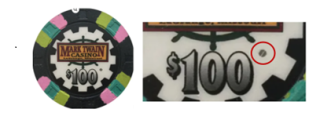RFID is the main high-tech security feature these days. You can even find them in low-cost low-end chips.
Interestingly, one of the main security features of high-end poker chips is simply that they're difficult to make! So-called "clay" chips (which are actually made of a mixture of plastic and clay) are made using compression molding. The chips are formed into blanks, then the blanks plus the inlay are placed in a mold inside a heated press. The process looks like this:
View attachment 906842
And here's an example of a mold that the blanks are pressed in:
View attachment 906843
The result is an object that has multiple characteristics that are easy to observe but difficult to reproduce without having access to the same type of equipment and a very close duplicate of the mold. The equipment is expensive to buy or manufacture, and expensive and difficult to operate.
In other words, the chips themselves are hard to counterfeit without a substantial investment - which dramatically reduces the likelihood of successful opportunistic counterfeiting!
What can you look for on a compressed clay poker chip to ensure it's authentic?
- The inlay is inlaid, meaning it is pressed into the surface of the chip during the molding and pressing. It sits flush with the chip's surface. The transition from the inlay to the surrounding chip material is seamless. Only compression molding can accomplish this. Injection-molded chips have decals rather than inlays; they're essentially stickers, and they're adhered to the surface of the chip. It's trivial to spot the difference, and even if someone is extremely careful in cutting and applying the sticker to try and make it fit precisely within the injection-molded chip's recess, if you look closely you'll be able to tell. In fact, you can even tell without looking, just by feeling! Running a finger or fingernail across the face of the chip, you will feel a gap or seam on the stickered chip whereas you'll feel a smooth flat surface on the genuine chip.
- The inlay is textured. The mold's surface has a texture to it, and it imparts that texture uniformly to both the surface of the chip and the surface of the inlay. The texture has a grain. If anyone were to remove and replace the inlay, it would not have the same texture as the original; the texture on the counterfeit inlay would not match the texture of the surrounding chip, and even if you replaced it with a real inlay from a different chip using the same mold (so that it had the same texture) the grain of the texture would not match either in position or direction.
- The edge spots have natural variation. When the chip is pressed, the "clay" is squished before being melted together and then cured solid by the heat of the press. That squishiness means that every chip is slightly different, and you can easily see the difference between any two otherwise identical chips by looking at the borders of the colored spots. They'll be ragged, and they'll be unique. Injection-molded chips will be identical because their spots are part of the mold; by looking at any two examples, you'll see that they are exactly the same whereas you'd expect genuine compression-molded chips will show small but easily observed differences.
- They have distinctive molds. In the example above, the chip's mold is a number of horseheads running around the edge. There are many different edge mold designs, but they all have something in common - they're simple enough to assess visually but complex enough that a counterfeiter would have to invest substantial effort and care in order to reproduce them. Obviously that's possible - people duplicate currency, after all - but it serves as a strong deterrent to casual or opportunistic forgeries.
Taken together, these sorts of features ensure that if a high-end clay poker chip
looks real, then it almost certainly
is real. And for a long time, this was the only level of assurance that casinos and card rooms had! Clay chips go back a hundred years, and from the very early days the manufacturers touted to their customers that by adding in distinctive features such as the insignia or stamp of the card room - i.e. customizing the chips for each specific customer - the casino could defeat the scourge of "ringers" - chips that were brought in from outside and then passed off as genuine inside. And they did! The security rested upon the difficulty of manufacturing the chips. An object that is so seemingly simple turns out to be expensive to produce - and difficult to duplicate without going through that very same expense!
But casinos are rightly paranoid because counterfeiters are highly motivated and very clever. So over time the manufacturers added things like microdots and holograms and etched serial numbers and eventually RFID. But the very first security feature in the very first chip was simply... being a poker chip! A high-quality artifact with visible characteristics from its method of production.
Good luck with your paper! We'd be interested to read it when it's done, if you feel like sharing.


